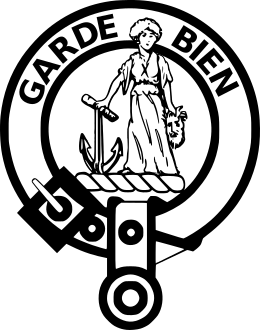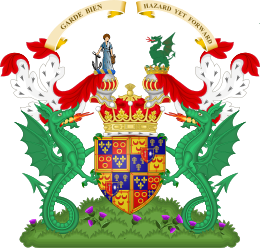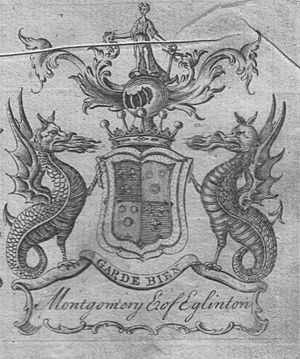Clan Montgomery facts for kids
Quick facts for kids Clan Montgomery |
|||
|---|---|---|---|
| MacGumerait | |||

Crest: A lady dressed in ancient apparel Azure holding in her dexter hand an anchor and in her sinister hand the head of a savage couped suspended by the hair all Proper
|
|||
| Motto | Garde bien (Watch well) | ||
| Profile | |||
| Region | Lowlands | ||
| Chief | |||
 |
|||
| Hugh Archibald William Montgomerie, Earl of Eglinton and Winton | |||
| The 19th Earl of Eglinton and 7th Earl of Winton | |||
| Seat | Balhomie, Perthshire. | ||
| Historic seat | Eglinton Castle | ||
|
|||
|
|||
|
|||
Clan Montgomery (also spelled Montgomerie) is a famous Scottish clan from the Scottish Lowlands. A clan is like a large family group, often with a shared history and a chief.
History of the Clan Montgomery
Where the Clan Began
The Montgomery family first came to Scotland from Wales in the 1100s. They arrived with another important family, the FitzAlans. The Montgomery name likely comes from a place in Wales called Montgomery. It's important to know that this Scottish clan is different from another famous Montgomery family in Normandy, France.
The first known Montgomery in Scotland was Robert of Montgomery. The clan's earliest lands in Scotland were in a place called Eaglesham, in Renfrewshire. The family became much more important in the 1300s. This happened when they married into the Eglinton family. Through this marriage, they gained the large Eglinton estates.
Fighting for Scotland's Freedom
In 1296, John de Montgomery and his brother were recorded as showing loyalty to King Edward I of England. This was during a time when England tried to control Scotland.
Later, a brave knight named Sir John Montgomery became a hero. He fought in the Battle of Otterburn in 1388. In this battle, the Scottish forces defeated the English. Sir John even captured a famous English knight, Henry "Hotspur" Percy. The Percy family paid a lot of money to get Hotspur back. Sir John used this money to build a strong castle called Polnoon Castle.
Clan Fights in the 1400s and 1500s
In 1488, Hugh Montgomery, the third Lord Montgomery, was on the winning side at the Battle of Sauchieburn. After this, he was given control of the Isle of Arran. However, this led to a big rivalry with Clan Cunningham. The Cunninghams believed they should control the area. This started a long and fierce feud between the two clans. The Cunninghams even burned down the Montgomerys' Eglinton Castle. In return, the Montgomerys burned down the Cunninghams' Kerelaw Castle.
The feud continued for many years in the 1500s. There were many fights and attacks between the clans. In 1528, the Cunninghams again burned down Eglinton Castle.
A sad event happened in 1586. Hugh Montgomery, the 4th Earl of Eglinton, was traveling to Stirling. He stopped for a meal at Lainshaw Castle. While he was there, a plan was made to attack him. As he crossed a river, thirty Cunninghams attacked. They killed the Earl and his servants.
When the Montgomerys found out, they sought revenge. They killed many Cunningham family members and supporters. The government of King James VI of Scotland eventually stepped in. They made the chiefs of both clans agree to stop fighting. The feud finally ended in 1661. This was when Margaret Montgomery married William Cunningham, the 9th Earl of Glencairn.
In 1568, the 2nd Earl of Eglinton supported Mary, Queen of Scots. He fought for her at the Battle of Langside. However, Queen Mary was defeated. The Earl was put in prison but was later released.

Around 1600, another clan, the Clan MacAlister, attacked the Montgomerys. They stole many valuable things from John Montgomery of Skelmorlie. Later, the MacAlisters were declared rebels and faced serious consequences.
The 1600s and Civil War
After being released from prison, the 2nd Earl of Eglinton tried to help Catholics after the Reformation. His daughter, Lady Margaret, married Robert Seton, the 1st Earl of Winton. Robert Seton was a loyal supporter of the Covenanters. These were people who did not agree with King Charles I of England's religious policies.
Their son, Alexander Seton, later took his mother's family name, Montgomery. He became the 6th Earl of Eglintoun. He supported King Charles II. Because of his loyalty to the King, he was put in prison in 1659.
In 1628, some Scottish Montgomerys moved to Ulster, in Ireland. A very famous Montgomery, 1st Viscount Montgomery of Alamein, came from this family line.
During the 1600s and 1700s, many Montgomerys served as soldiers in armies across Europe. They fought for countries like Sweden, France, and Russia.
The 1700s and Jacobite Uprisings
During the Jacobite Uprisings, the Clan Montgomery supported the British government. The clan chief, the 9th Earl of Eglinton, helped train soldiers for the government in 1715.
Seven Years' War
In 1757, Archibald Montgomerie, the 11th Earl and chief of Clan Montgomery, raised a special army regiment. This was the British 77th Regiment of Foot. It was made up of members of the Montgomery clan and other clans. This regiment helped build Fort Pitt in America. This fort later grew into the city of Pittsburgh.
American Revolutionary War
During the American Revolutionary War, General Richard Montgomery fought for the American side. He led an attack on Quebec City in Canada in 1775. His forces captured Montreal. Then, he joined forces with Benedict Arnold to attack Quebec City on December 31. The battle was a big loss for the Americans, and General Montgomery was killed. Many places in the USA are named "Montgomery" in his honor.
World War II Hero: Bernard Montgomery
Perhaps the most famous Montgomery of all was Field Marshal Bernard Montgomery, also known as "Monty." He was a very important British Army officer during the Second World War.
Bernard Montgomery was born into a family of Scottish Montgomerys who had settled in Ulster, Ireland, in 1628.
During the war, Montgomery led the British Eighth Army in North Africa. He was famous for his victory at the Second Battle of El Alamein in 1942. This was a turning point in the war. He then led his troops in the invasions of Sicily and Italy.
Montgomery was also in charge of all Allied ground forces during the Battle of Normandy on D-Day, June 6, 1944. This was a huge operation to free Europe from Nazi control. He continued to lead forces through the rest of the war in North West Europe. This included important battles like Operation Market Garden and the Battle of the Bulge.
By the end of the war, Montgomery's troops had helped free the Netherlands and capture much of northern Germany. On May 4, 1945, Montgomery accepted the German surrender. This was a major moment that helped end the war in Europe.
Castles and Mansions of the Montgomerys
The Clan Montgomery owned many impressive castles and large houses over the centuries. Here are some of them:
- Annick Lodge
- Ardrossan Castle
- Bourtreehill House
- Caldwell Castle
- Little Cumbrae Castle
- Cunninghamhead Estate
- Dalmore House and Estate
- Eglinton Castle
- Barony and Castle of Giffen
- Hessilhead Castle
- Lainshaw
- The Lands of Montgreenan
- New Park in Moville, Inishowen, County Donegal
- Polnoon Castle
- Seagate Castle
- Skelmorlie Castle, near Largs
- Stanecastle
See also
- Montgomery (name)
- Counts de Montgomerie, Earls of Shrewsbury a noble family of Anglo-Norman origin
- Mac Con Iomaire and Mac an Iomaire – Gaelicised (Irish) forms of the surname Montgomery
- Industry and the Eglinton Castle estate
- Susanna Montgomery, Lady Eglinton
- Robert Burns and the Eglinton Estate
- Eglinton Country Park




